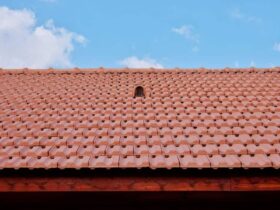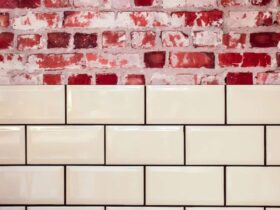Slate is primarily composed of quartz and muscovite or illite, often accompanied by biotite, chlorite, hematite, and pyrite. This fine-grained metamorphic rock is derived from shale through the process of slate metamorphism.
Slate has been used for roofing and flooring for centuries due to its unique texture and durability. It is a popular choice for construction due to its ability to withstand high-pressure and temperature. Slate is produced through a natural process where shale, a sedimentary rock, undergoes metamorphosis due to heat and pressure.
As a result, the fine particles in shale realign and compress, forming the unique texture that distinguishes slate from other rocks. It is important to note that slate is not an igneous rock, but rather a type of metamorphic rock. Understanding the composition of slate is crucial for construction workers and geologists who study the properties of rocks.
Overview
Slate is a fine-grained metamorphic rock that is primarily composed of quartz and muscovite or illite. It is often accompanied by biotite, chlorite, hematite, and pyrite. Slate is produced from shale through the process of slate metamorphism, and it has a smooth, flat, layered appearance due to its alignment of mineral grains.
ically formed through metamorphism, but they differ in their composition and texture. Understanding the composition of slate is important because it is used in many applications, from roofing materials to floor tiles.
Definition Of Slate
Slate is a fine-grained metamorphic rock that is created through the process of low-grade metamorphism of shale or mudstone. This process involves the application of heat and pressure that results in the reorganization of the minerals within the rock, creating a strong, layered structure with a distinct cleavage. The color of the slate can vary depending on its origin and the minerals present.
Importance Of Understanding Slate’s Composition
Understanding the composition of slate is crucial in many applications. For example, when used as a roofing material, the composition of slate determines its durability, color, and texture. Other factors such as moisture content, porosity, and thermal conductivity can also be affected by its composition. Additionally, knowing the minerals present in slate can help identify its geographical origin, making it easier to choose and source the right material for specific applications.
In conclusion, slate is a versatile rock that is highly valued for its durability and distinctive appearance. Understanding its composition is crucial in choosing the right type of slate for various applications. The minerals present in slate can affect its properties and characteristics, making it important to identify its composition before using it in any project.
Composition Of Slate
Slate is a metamorphic rock primarily composed of quartz and muscovite or illite, often accompanied by biotite, chlorite, hematite, and pyrite. It forms from low-grade metamorphism of shale or mudstone and has a fine-grained texture with a smooth, flat, and layered appearance.
It is commonly used for roofing, flooring, and other construction purposes due to its durability and natural beauty.
ate are both metamorphic rocks that have undergone different degrees of heat and pressure. In this section, we will focus on the composition of slate, which is a fine-grained metamorphic rock derived from shale through the process of slate metamorphism. Slate is primarily composed of quartz and muscovite or illite, often accompanied by biotite, chlorite, hematite, and pyrite. In the following sections, we will discuss each of these components in detail.
Elemental Composition
Slate is mainly composed of the elements silicon, oxygen, aluminum, and potassium, which are found in abundance in shale, the parent rock of slate. The elemental composition of slate may vary slightly depending on the mineral impurities present in the original sedimentary rock.
Mineral Composition
The mineral composition of slate includes quartz and mica, which are the most abundant minerals in most rocks. Quartz provides the rock with durability, hardness, and resistance to weathering, whereas mica adds to the rock’s ability to cleave into thin sheets. Other minerals commonly found in slate include biotite, chlorite, hematite, and pyrite, which provide the rock with different colors and textures.
Formation Process
Slate is formed from the metamorphism of shale, a sedimentary rock made of very fine particles. To transform shale into slate, it needs to be exposed to heat and pressure, which causes the minerals in the rock to recrystallize and align themselves in parallel fashion. This process creates foliation, which is the characteristic feature of slate, giving it the ability to cleave into thin sheets with a smooth surface.
In conclusion, the composition of slate is unique and made up of various minerals. Understanding its composition and formation process can help you appreciate the rock’s beauty and importance in industries such as roofing, flooring, and decorative stones.
Metamorphic Rock Types
Slate is a fine-grained metamorphic rock that primarily consists of quartz and muscovite or illite. It may also contain biotite, chlorite, hematite, and pyrite. Slate is produced by the low-grade metamorphism of shale or mudstone through exposure to heat and pressure.
Metamorphic Rock Types:
Metamorphic rocks are formed by the effects of heat, pressure, and chemical reactions on pre-existing igneous, sedimentary, or other metamorphic rocks. Slate, phyllite, schist, and gneiss are some of the common metamorphic rocks. In this post, we will discuss the composition of slate and compare it with phyllite, schist, and gneiss, under the subheading “Metamorphic Rock Types”.
Slate Vs. Phyllite
Slate is a fine-grained metamorphic rock that is derived from shale, a sedimentary rock. It is primarily composed of quartz and muscovite or illite, along with other minerals such as biotite, chlorite, hematite, and pyrite. Phyllite results from the continued metamorphism of slate, has slightly coarser grains, and displays a sheen from tiny mica flakes. Unlike slate, phyllite has a “phyllitic” sheen and has a slightly coarser texture. Phyllite is also rich in micas and other minerals, like chlorite.
Phyllite Vs. Schist
Schist is a coarse-grained metamorphic rock with visible mica crystals and displays a more pronounced foliation. It forms at higher temperatures and pressures than phyllite. Phyllite has a slightly coarser texture and is enriched with micas and other minerals. It is due to the increased heat and pressure which results in the crystals in the rocks becoming larger. Schist is used in construction and in manufacturing as a decorative stone because of its characteristic mica glitter.
Schist Vs. Gneiss
Gneiss is a high-grade metamorphic rock with a banded or gnarled appearance due to the segregation of mineral grains into alternating light and dark bands, which is called gneissic banding. It forms under higher temperature and pressure conditions than schist. One of the most notable differences between schist and gneiss is the texture. Schist has a characteristic coarse-grained texture, while gneiss has a more layered appearance due to the segregation of mineral grains into alternating light and dark bands. Gneiss is used as a building stone, in landscaping, and as a decorative stone for facing buildings.
In conclusion, metamorphic rocks like slate, phyllite, schist, and gneiss have their own unique compositions and textures. Understanding these differences is important as it helps in identifying and classifying these rocks.
Texture Comparison
Slate is a metamorphic rock composed primarily of quartz and muscovite or illite, along with biotite, chlorite, hematite, and pyrite. It is produced by the metamorphosis of shale, which hardens and reforms due to heat and pressure. Slate has a fine-grained texture and exhibits strong cleavage, making it a popular choice for roofing and flooring.
ocks, but they have different textures due to their composition and formation. Slate has a very fine-grained texture, sometimes described as “fissile” or easily split into thin layers. This texture is a result of the alignment of clay and other minerals present in the original shale, which were compressed and heated during metamorphism. Schist, on the other hand, has a coarser texture with visible minerals such as mica and quartz. This is because schist forms from higher-grade metamorphism with greater pressure and temperature than slate. Let’s explore each texture further in detail.
Slate Texture
Slate is a fine-grained metamorphic rock that has a very smooth and even texture, making it ideal for roofing tiles and other building materials. The most distinct characteristic of slate is its regular and consistent foliation, which gives it the ability to split easily into thin layers. This foliation is formed when pressure and heat cause clay minerals in the original shale to align perpendicular to the direction of stress. As a result, slate has a very smooth and even texture.
Schist Texture
Schist has a coarser texture than slate, with visible minerals such as mica and quartz. These minerals give the rock a distinctive layered or banded appearance. Schist forms from higher-grade metamorphism with greater temperature and pressure than slate. This causes the minerals in the original rock to recrystallize and align in the same direction, producing the layering and banded texture.
In conclusion, the texture of slate and schist varies due to their distinct compositions and the conditions under which they form. Slate has a very smooth and even texture due to the alignment of clay minerals, making it easy to split into thin layers. Schist, on the other hand, has a coarser texture with visible minerals such as mica and quartz, giving it a layered or banded appearance.
Applications
Slate is a fine-grained metamorphic rock primarily composed of quartz and muscovite or illite, often accompanied by biotite, chlorite, hematite, and pyrite. It is produced by the metamorphosis of shale, a sedimentary rock made of very fine particles, through low levels of heat and pressure.
Applications
Slate, one of the most durable and elegant natural stones, has great functionality in a variety of applications. The unique composition and texture of slate make it an ideal material for roofing tiles, writing tablets, and many other uses.
Roofing Tiles
Slate roofing tiles have been popular for centuries due to their longevity and resistance to extreme weather conditions. The durability of slate tiles makes them highly desirable for roofing applications, as they can last for over a century with proper maintenance. The distinctive texture and color of slate tiles can add a touch of elegance to any building while providing protection from environmental elements.
Writing Tablets
Slate has been used for writing tablets for hundreds of years. The smooth surface of slate makes it easy to write on and erase, making it an ideal material for tablets. The sturdy and durable nature of slate tablets meant they could be used again and again, making them a popular writing medium in the past. Even in the age of computers, slate tablets remain popular among artists and writers for their unique texture and feel.
In conclusion, the composition and texture of slate make it a versatile and functional material that can be used in a variety of applications. Roofing tiles and writing tablets are just a few examples of the many uses of slate, making it a valuable natural resource.

Credit: www.nytimes.com
Frequently Asked Questions On What Is The Composition Of Slate
What Is The Chemical Formula Of Slate?
The chemical formula of slate is not applicable as it is a metamorphic rock formed from shale through the process of slate metamorphism. It is primarily composed of quartz and muscovite or illite, often accompanied by biotite, chlorite, hematite, and pyrite.
It has a fine-grained texture and splits into thin sheets, making it a popular choice for roofing tiles and as a material for writing tablets.
What Is Made Of Slate?
Slate is a metamorphic rock primarily composed of quartz and muscovite or illite, with accompanying biotite, chlorite, hematite, and pyrite. It is derived from shale through low-grade metamorphism, and has a fine-grained texture that often splits into thin sheets, making it popular as a roofing material and writing surface.
Schist, on the other hand, has a coarser texture with larger mineral grains arranged into distinct bands or layers.
What Is The Parent Rock Of Slate?
Slate is a metamorphic rock derived from shale, composed of quartz and muscovite or illite, sometimes accompanied by biotite, chlorite, hematite, and pyrite. Shale undergoes low-grade metamorphism from heat and pressure to form slate. Slate has a very fine-grained texture and often splits into thin sheets.
It is not an igneous rock.
What Is The Natural Form Of Slate?
Slate has a natural form that is fine-grained and exhibits a smooth, flat, and layered appearance due to its mineral composition. It is primarily composed of quartz and muscovite or illite, along with other minerals like biotite, chlorite, hematite, and pyrite.
Slate is a metamorphic rock formed from low-grade metamorphism of shale or mudstone. It often splits into thin sheets and is used for roofing tiles and writing tablets.
What Is The Mineral Composition Of Slate?
Slate is primarily composed of quartz and muscovite or illite, often accompanied by biotite, chlorite, hematite, and pyrite.
Conclusion
Slate is a fine-grained metamorphic rock that is derived from shale through the process of metamorphism. Its mineral composition primarily consists of quartz and muscovite or illite, along with other minerals such as biotite, chlorite, hematite, and pyrite. The texture of slate is smooth and flat, while schist has a coarser texture and distinct bands or layers.
Understanding the composition and properties of slate can help us appreciate the unique qualities of this rock and its relevance in various applications, from roofing tiles to writing tablets.









Leave a Reply